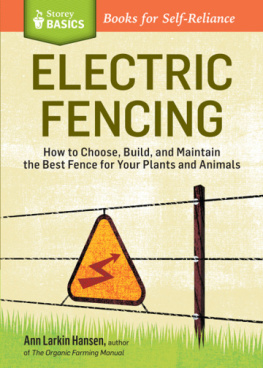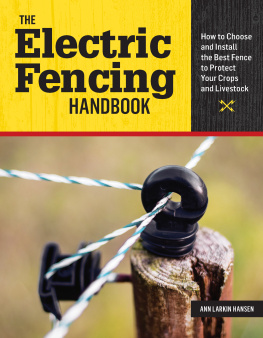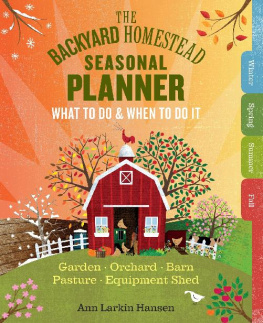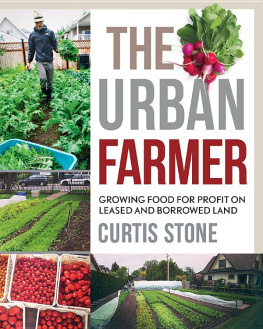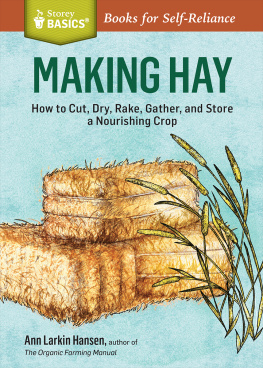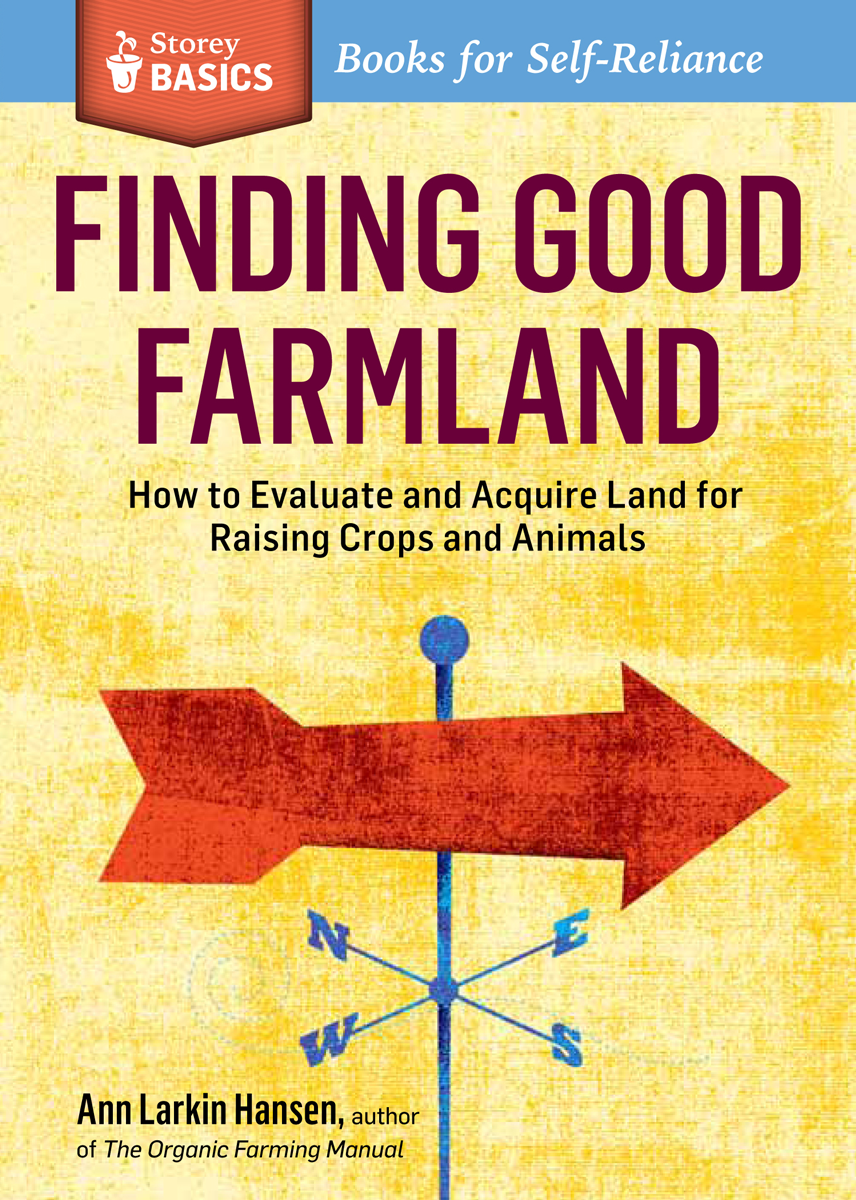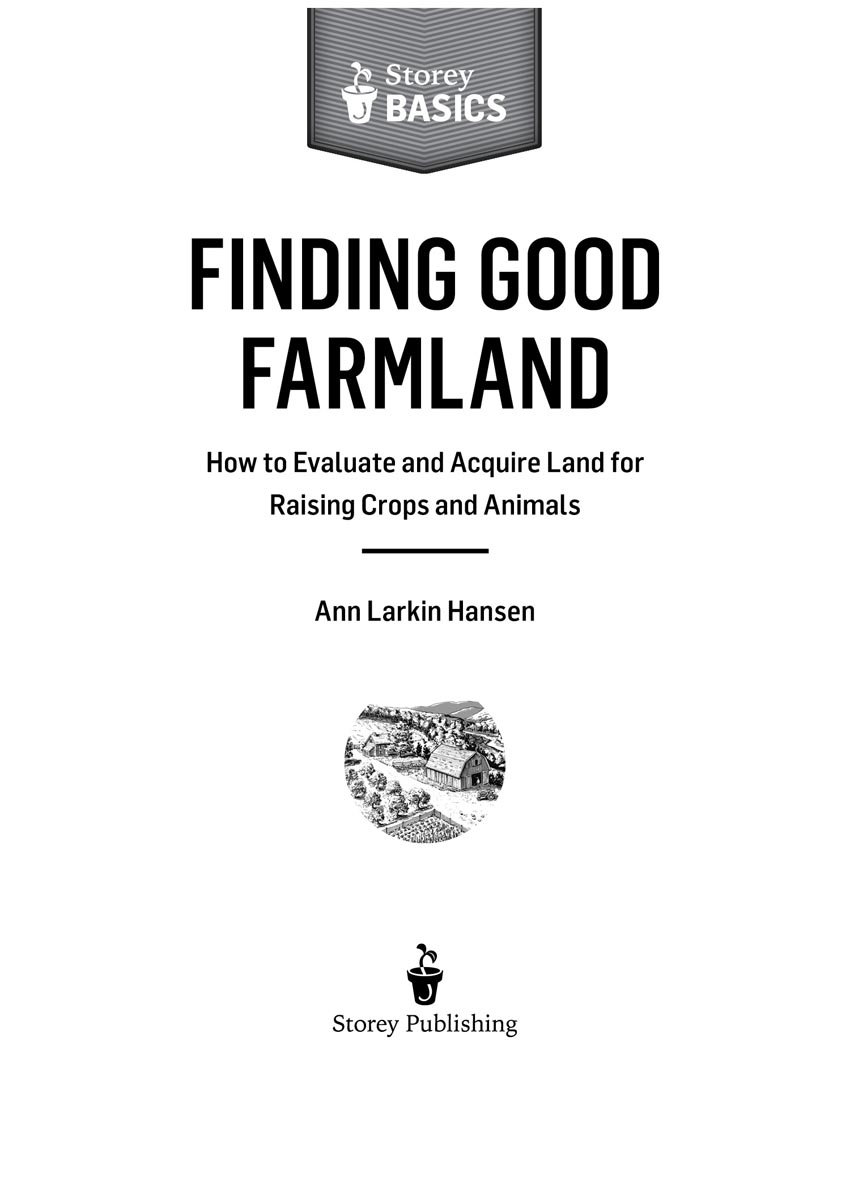The mission of Storey Publishing is to serve our customers by publishing practical information that encourages personal independence in harmony with the environment.
Edited by Deborah Burns
Art direction by Carolyn Eckert
Text production by Teresa Wiscovitch
Cover illustration by Michael Austin/Jing and Mike Company
Interior illustrations by Steve Sanford, except for sketches, , by Deborah Burns
2013 by Ann Larkin Hansen
Ebook design by Dan O. Williams
Ebook production by Kristy L. Rustay
Ebook version 1.01
April 3, 2013
All rights reserved. No part of this book may be reproduced without written permission from the publisher, except by a reviewer who may quote brief passages or reproduce illustrations in a review with appropriate credits; nor may any part of this book be reproduced, stored in a retrieval system, or transmitted in any form or by any means electronic, mechanical, photocopying, recording, or other without written permission from the publisher.
The information in this book is true and complete to the best of our knowledge. All recommendations are made without guarantee on the part of the author or Storey Publishing. The author and publisher disclaim any liability in connection with the use of this information.
Storey books are available for special premium and promotional uses and for customized editions. For further information, please call 1-800-793-9396.
Storey Publishing
210 MASS MoCA Way
North Adams, MA 01247
www.storey.com
Contents
Finding the farm thats right for you
Where to look for land, and how to begin the search
Source, quantity, reliability, ownership, and quality
Soil type, fertility, aspect, slope, drainage, and field histories
House, outbuildings, fences, septic, electric, driveway, and a few other things
Finding out who the neighbors are and what theyre doing, now and in the future, and the overall quality of life in the area
Permits and codes, land use planning and zoning, property taxes, protections and programs for farmers, roads and other government services
Finding a lender and convincing them to give you a loan
Additional ways to acquire land to farm
To the Reader
This book assumes that you are looking for rural property to use as your primary residence with the intention of engaging in small-scale organic farming of some type (livestock, dairy, fruits, vegetables, field crops, specialty crops, or a little bit of everything). I truly hope that this book sets you solidly on the path to your own beautiful farm and a lifetime of green days and starry nights. We found it; you can too. ALH
Introduction
The perfect organic farm for you is:
- Located in a region with a climate and landscape you understand and enjoy.
- Reasonably close to the farm markets and/or job opportunities you will need.
- Reliably supplied with abundant, clean water year-round.
- Blessed with enough farmable acreage, the right type of soil, good drainage, and terrain suited to the type of farming you plan to do.
- Equipped with a soundly constructed house and outbuildings in good repair, or a good building site.
- Available for sale with water and mineral rights included.
- Situated in a neighborhood unspoiled by difficult neighbors, uncontrolled development, flooding, or environmental problems.
- Appropriately regulated by government bodies that care about farmers.
- Affordable for your budget.
- Beautiful in your eyes.
The truth is that no property is perfect: there are always drawbacks. If you cant spot the problems and the potential of a farm for yourself, the next six chapters discuss what questions youll need to ask (and why) to determine if a property could turn into your private purgatory, or has enough of the above attributes to become the beautiful small-scale organic farm of your dreams.
Finding good land, however, is only the first part of the equation. The second half financing the purchase is a major barrier for new farmers. There are no simple ways around this barrier, but you have options, including tapping into the expanding resources available to help new farmers. The final two chapters cover both traditional and creative methods for financing a land purchase.
In Recommended Reading on youll find a list of publications that will assist you further in your search; you will certainly find more as your journey continues.
Chapter One
Location
Why not begin searching for land now, even if youre not yet in a position to buy? Looking will clarify what you want for your farm and what is available.
The more you know about farming in general, your targeted locales, and how real estate ads compare to real estate reality, the better youll be at spotting opportunities and avoiding problems. Drive rural neighborhoods, vacation where you hope someday to live, subscribe to the local paper, seek an internship or job on a farm, watch real estate ads, and go to small farm conferences and field days. Talk to everyone: real estate agents, Extension agents, farmers market vendors, and the appliance repair guy. The Internet wont tell you which farms have poor wells or where the next big pig operation is getting built; the retired farmers hanging out at the local caf might.
Commercial Farm Types
Aside from the subsistence farm, there are five basic types of commercial farms raising five types of products: vegetables and/or small fruits; tree fruits; field crops; dairy; meat or fiber animals (poultry, pigs, and grazing livestock).
There are many specialty crops as well, but in terms of what markets and land base they need, they will generally fit into one of these slots.
The type(s) you focus on will determine how much land and what sort of climate, soil, terrain, and rural neighborhood you will be seeking. You can, in fact, raise almost any category of farm product almost anywhere, but if you intend to make money, or at least not bleed yourself dry, you must have land appropriate to the enterprise and a reliable market where you can sell your products for more than it cost you to raise them.
Four Key Questions at the Start
As you look for land, define where and what kind of land you want by answering four questions:
- Do you want to generate most of your income on or off the farm? Does access to off-farm employment or to good farm infrastructure and markets have priority?
- What would you like to produce? If your intent is to sell farm products, you need land appropriate for your enterprise, and good markets.
- What are the other people involved in your farming venture looking for? You may not care whether there are friends or a decent job close by, but your spouse or partner might. Children (whether present now or a future possibility) might want to live close enough to town to avoid hours-long school bus rides.
- How will these needs and wants change in the long term? Consider whether an area will also suit you when you are older when adventure becomes less important and convenience more so.


